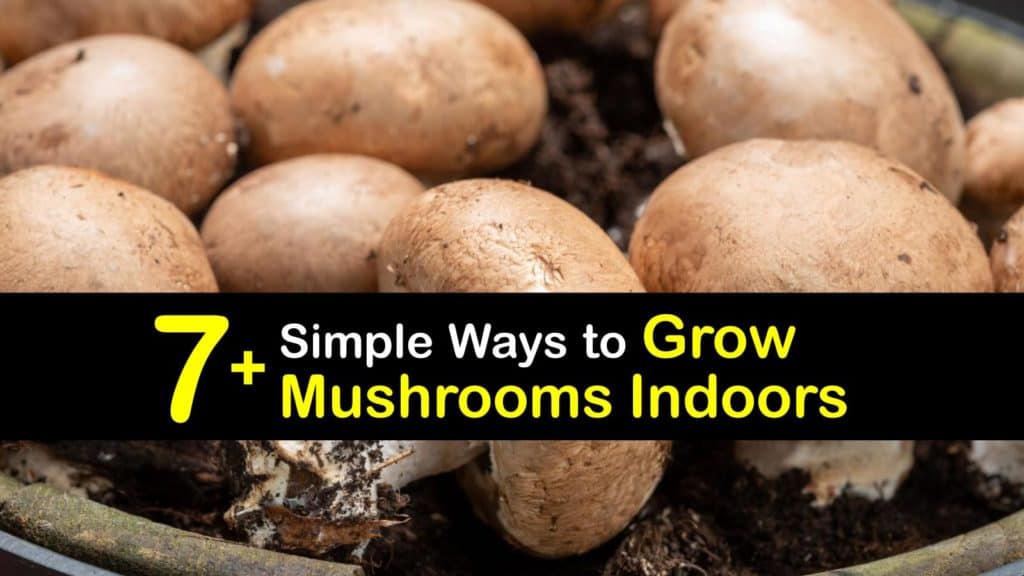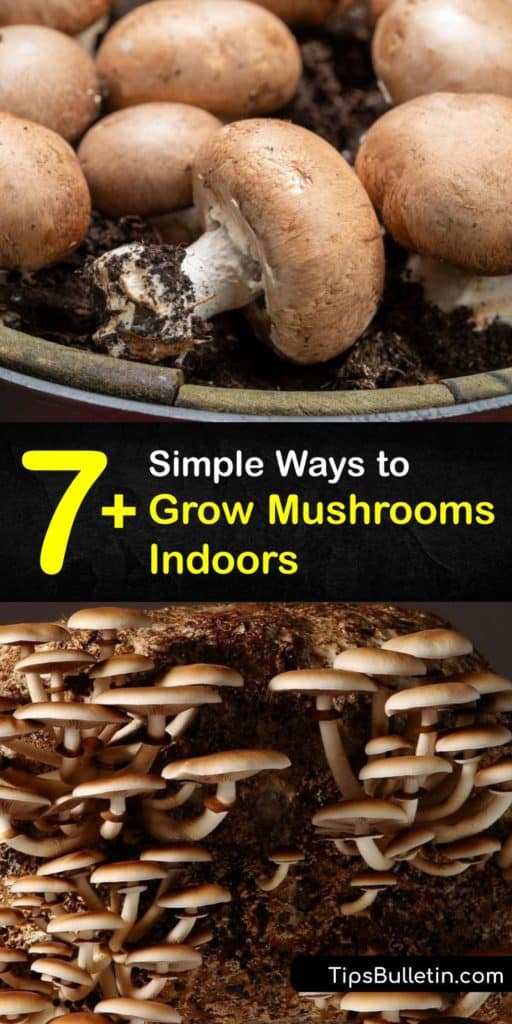People fill their gardens with veggies like tomatoes, zucchinis, and peppers every spring, but you don’t often try to grow your own mushrooms. Can you grow mushrooms indoors the same way you grow other plants? Learning how to grow mushrooms indoors is different than growing other types of plants.
Mushrooms are a fungus and spread uniquely compared to some of the other foods we eat. This growing process means that caring for them and giving them the right atmosphere to thrive in isn’t as straightforward as burying a seed in dirt and watching it rise from the soil.
Growing mushrooms indoors take a little more effort than people often think. People often rely on grocery stores to supply them with various kinds of fungi. Morel, portobello, maitake, shiitake, lion’s mane, and oyster mushrooms are only some of the delicious types of mushrooms available, but it’s possible to grow mushrooms at home much cheaper.

What to Know Before Growing Mushrooms Indoors
Once you familiarize yourself with the process, you can keep these savory nuggets in your kitchen throughout the year. The life cycle of mushrooms is separate from the life cycle of plants and animals. The fungi require unique environments that are quite the opposite of other plants.
Realistically, how long does it take to grow mushrooms inside? This timeline depends on the size of the mushrooms. One benefit to caring for mushrooms is that they grow extremely fast.
Small mushrooms may develop in as little as one day, while larger ones only require three or four days to mature.
Try to think of the mushrooms that we eat as the fruiting body of the fungi. The fungi reproduce by releasing mushroom spores found on the gills of the fruit. The spores are similar to seeds and are either male or female.
Each spore groups up with other spores. Groupings of the same spores are called hyphae. When one hyphae group meets up with another, they combine to begin the growing process and produce mycelium.
Mushroom mycelium is similar to the roots of plants. This web-like structure remains underground but continues to branch out and provide nutrition to start creating the mushrooms’ body for us to snack on.
Can You Grow Mushrooms Indoors?
Learning how to grow mushrooms indoors is entirely possible with a little bit of research. Mushroom growing kits are available for purchase online, but there are some cheaper DIY ways to do it.

Some of the most common varieties of mushrooms that growers like to start with are shiitake, oyster, and white button mushrooms because they are less picky than some other types.
How to Grow Mushrooms Indoors
There are several ways to grow mushrooms, but this strategy is one of the best despite being a little more laborious. Try starting with oyster mushrooms because they offer more room for error than other types.
Collect enough organic growing medium so that it overfills your bucket. This material could be anything like old garden debris, coffee grounds, hardwood sawdust, or straw.
Fill a large stockpot about halfway full of water and heat it until it reaches 160°F. Carefully pack the substrate into the hot water.
Set a heavy object, such as a brick, inside the colander and then put the colander in the pot, so the substrate becomes weighed down. Keep the water at 160°F for two hours.
Drill holes into your bucket at eight-inch intervals with a 3/8-inch drill bit. Wipe the bucket and lid down with the bleach wipes to disinfect it and refrain from touching it to spread more germs.
Strain the substrate from the pot using the wire scoop and spread it on the plastic trash bags to cool. Sprinkle the sawdust mushroom spawn over the organic matter and mix it.
Pack the mixture into the bucket and replace the lid. Store the bucket in a location that is dark, cool, and humid. A cold basement is a perfect spot.
After two to four weeks, the mushrooms become completely colonized, and tiny mushrooms start to grow from the holes you drilled in the buckets. Harvest the oyster mushrooms when the edges of their caps turn up.
Pick them once more about two or three weeks later. If your bucket is placed in ideal conditions, you may be lucky enough to get four or five harvests from one bucket.
Alternative Ways to Grow Mushrooms
There isn’t only one strategy for growing mushrooms indoors. This process is similar to the previous one in this article but uses various tools that are more likely already around your home.
Start by purchasing your choice of mushroom spawn. Fill a large bowl with an organic substrate and dampen the matter with water. Microwave the bowl for two minutes to kill off microorganisms.
Place a few handfuls of the sterile substrate into a baking pan and mix in the mushroom spawn. Place the mushroom growing pan on a heating pad set to 70°F to encourage growth.
Leave the pan in a dark environment where it is away from direct sunlight for three weeks. Once the substrate is covered in fuzz, move the pan into a cool, dark environment where temperatures are around 55°F.
Cover the substrate is potting soil and dampen it with water. Place a damp towel over the top of the pan to stop moisture loss. Respray the pan as often as necessary to keep things moist. Harvest your mushrooms once fully grown.
Grow Mushrooms with Coffee
Coffee grounds make an excellent homemade fertilizer for mushrooms. Fill grow bags or a plastic bag with dried coffee grounds. Grow bags are great because they have a filter patch that keeps out contaminants.
Inoculate the mushroom spawn into the coffee. Inoculation is introducing microorganisms into something. In this case, it’s the spores.
Once inoculating the coffee is complete, seal the grow bags and store them in a warm, dark place between 64°F and 77°F until white fuzz appears on top.
Water the spores twice per day during this time. The fruiting bodies begin to sprout after a week and are ready to harvest when they reach full size.
Making Agar Plates for Mushrooms
If you really want to feel like a scientist, growing mushrooms on agars is another simple way to care for them.
Agar plates contain a jelly-like substance that helps organisms expand. Purchase these plates online or learn how to sterilize and start them at home.
Using Mushroom Growing Kits
Mushroom kits are one of the easiest ways to grow mushrooms. These kits are great for first-timers and cost roughly 30 dollars.
Most kits require you to place the kit in a bright location, without direct sunlight, and watering it until they sprout after one week. When finished with the kits, most can be buried outside to produce mushrooms outdoors as well.
When to Harvest Mushrooms
Size isn’t always the determining factor when harvesting mushrooms. Bigger doesn’t always mean that the mushroom is better or ready to be picked.
In general, most mushrooms are ready for harvesting when the caps turn from convex to concave and are entirely separated from the stem.
There isn’t a specific strategy to take when harvesting mushrooms. Some growers twist and pull them, while others cut them. Whatever is most comfortable for you will work.
After you pick your mushrooms, use them in a delicious recipe or learn how to preserve them to eat later. Answer questions like, “Can you freeze raw mushrooms? or ” How long do mushrooms last in the fridge?”
It’s important to know what fresh mushrooms shelf life is so you don’t waste any of the mushrooms you worked so hard to grow.
Common Pests and Diseases
As exciting as it is to start growing mushrooms indoors, several pests and diseases may create some problems on your journey. Sciarid flies and fungus gnats are some of the most common pests for indoor mushrooms.
They leave the caps leathery and inedible. Spraying the mushrooms with a hydrogen peroxide and water mixture keeps some of these pests at bay.
Green mold is the most serious disease that growers face. This mold leaves the mushrooms cracked and distorted. To keep green mold away, make sure you properly pasteurize your substrate to kill all microorganisms.
Start Small
Growing fruits and veggies is fairly labor-intensive, but growing indoor mushrooms requires even more labor. If you’re learning how to grow mushrooms indoors, make sure you start small.
Caring for too many mushrooms at one time quickly becomes overwhelming and means you might have too much work to handle.
Try growing one batch of mushrooms at first. If you’re not getting a large enough harvest and can put in more work, plant some more spores.
Can you grow mushrooms indoors? We might think that mushrooms can only be grown outside in the wilderness, but growing them in your own home is worth the work.
Mushrooms are rich in fiber, protein, and antioxidants and are proven to support our overall health. If you’re ready for the challenge, there’s no reason you shouldn’t start growing mushrooms indoors.

If this article helped you learn everything that goes into knowing how to grow mushrooms indoors, share these tips for healthy mushrooms on Facebook and Pinterest.